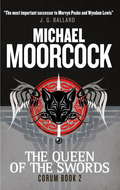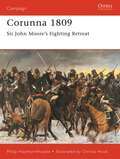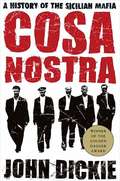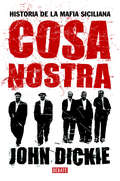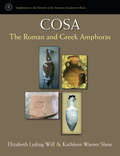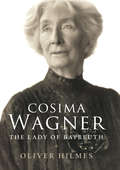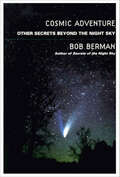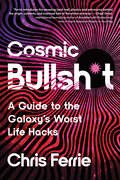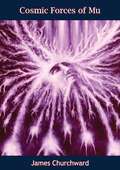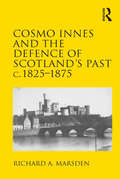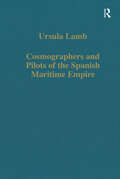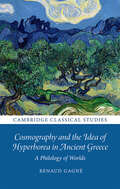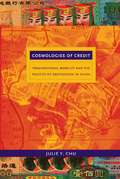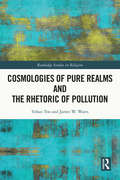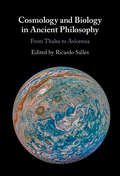- Table View
- List View
Corum - The Queen of Swords
by Michael MoorcockPrince Corum has defeated the Chaos Lord Arioch. But any peace for him and his faithful Rhalina is brief. His actions have evoked the murderous anger of Arioch's sister, the dreaded Xiombarg. The Prince in the Scarlet Robe must continue his odyssey, face the terror of the Mabden armies, and challenge the might of the Queen of the Swords. Faced with immense powers of evil on all sides, only the legendary City of the Pyramid offers a glimmer of hope. But Corum must get there first, and along the way he will encounter horrifying creatures, strange forms of sorcery, and new planes of existence.
Corum - The Sword and the Stallion
by Michael MoorcockThere is a sword, forged by the master swordsmith Goffanon the Dwarf, imbued with powerfully magical properties. But this magic can only be wielded by one man. And there is a stallion--a fierce animal that allows only those pure of heart to ride it. The only man worthy of taking up this sword, and climbing into this saddle, is Prince Corum--the Eternal Champion.The struggle for dominion between the races of good and evil is reaching an epic crescendo, and the formidable Gods of Limbo threaten to deliver unending Chaos to the world. Corum's most desperate quest yet will see treachery, betrayal, wizards, dragons and brutal battle, all of which will decide the fate of the Earth, and of Corum himself.
Corunna (Great Battles Ser.)
by Christopher Hibbert‘Not a drum was heard, not a funeral note,As his corse to the rampart we hurried.’—from ‘The Burial of Sir John Moore at Corunna’ by Charles WolfeOne of the best remembered poems in the English language has served to keep alive the memory of Sir John Moore and of his burial at Corunna on 17 January, 1809. The story of the battle which he fought on the previous day and of the short campaign and horrifying retreat which preceded it is, however, not so well known.The Battle of Corunna saved a British army from annihilation and resulted in the tragic death of one of England’s finest generals. Setting out from Lisbon in the autumn of 1808, Sir John Moore had marched his army into Spain against Napoleon and by a daring manoeuvre had thrown it across the line of French communications. But, having thus drawn off Napoleon’s army from Madrid, Moore found himself so outnumbered and with no hope of assistance from the ineffectual Spanish armies, that he decided to withdraw to the coast. After a 250-mile retreat across the mountains of Galicia under appalling weather conditions, with inadequate food supplies and the French hard on his heels, he eventually reached the port of Corunna. Here he turned and drew up his depleted forces to face Marshal Soult’s massive army; and, though mortally wounded in the ensuing battle, he lived long enough to learn that the French had been checked and that his own army would be able to embark in safety.In Corunna extensive use is made of the many eyewitness accounts which survive in the form of official despatches, histories, diaries, memoirs and letters. With the aid of these, Christopher Hibbert not only shows a remarkable understanding of John Moore and his fellow officers, of their conflicting characters and views, but also provides a horrifying picture of the hardships of this brief and bitter campaign.
Corunna 1809
by Christa Hook Philip HaythornthwaiteThe retreat to Corunna is one of the epic campaigns of the Napoleonic Wars (1799-1815). Late in 1808 Sir John Moore found himself virtually alone with his small British army deep inside Spain. The armies of his Spanish allies had been overwhelmed and he faced a victorious French force under the Emperor Napoleon. He had little option but to order a retreat to the port of Corunna. This became the most arduous of trials with armies traversing mountainous terrain over appalling roads in the depths of winter. Somehow Moore held his outnumbered, exhausted men together as they struggled to reach safety. Finally at Corunna Moore's army turned to face its tormentors.
Cosa Nostra: A History of the Sicilian Mafia
by John DickieThe Italian-American mafia has its roots in a mysterious and powerful criminal network in Sicily. While the mythology of the mafia has been widely celebrated in American culture, the true origins of its rituals, laws, and methods have never actually been revealed. John Dickie uses startling new research to expose the secrets of the Sicilian mafia, providing a fascinating account that is more violent, frightening, and darkly comic than anything conceived in popular movies and novels. How did the Sicilian mafia begin? How did it achieve its powerful grip in Italy and America? How does it operate today? From the mafia's origins in the 1860s to its current tense relationship with the Berlusconi government, Cosa Nostra takes us to the inner sanctum where few have dared to go before. This is an important work of history and a revelation for anyone who ever wondered what it means to be "made" in the mob.
Cosa Nostra: A History of the Sicilian Mafia
by John DickieCOSA NOSTRA is the compelling story of the Sicilian mafia, the world's most famous, most secretive and most misunderstood criminal fraternity. The mafia has been given many names since it was founded one hundred and forty years ago: the Sect, the Brotherhood, the Honoured Society, and now Cosa Nostra. Yet as times have changed, the mafia's subtle and bloody methods have remained the same. Now, for the first time, COSA NOSTRA reconstructs the complete history of the Sicilian mafia from its origins to the present day, from the lemon groves and sulphur mines of Sicily, to the streets of Manhattan. COSA NOSTRA is a definitive history, rich in atmosphere, and with the narrative pace of the best detective fiction, and has been updated to make it the most vital contemporary account of the mafia ever published.The mob genre has finally grown up.(P)2020 Hodder & Stoughton Limited
Cosa Nostra: Italy's Criminal Curse. Cosa Nostra, 'ndrangheta And Camorra From 1946 To The Present
by John DickieCOSA NOSTRA is the compelling story of the Sicilian mafia, the world's most famous, most secretive and most misunderstood criminal fraternity. The mafia has been given many names since it was founded one hundred and forty years ago: the Sect, the Brotherhood, the Honoured Society, and now Cosa Nostra. Yet as times have changed, the mafia's subtle and bloody methods have remained the same. Now, for the first time, COSA NOSTRA reconstructs the complete history of the Sicilian mafia from its origins to the present day, from the lemon groves and sulphur mines of Sicily, to the streets of Manhattan. COSA NOSTRA is a definitive history, rich in atmosphere, and with the narrative pace of the best detective fiction, and has been updated to make it the most vital contemporary account of the mafia ever published.The mob genre has finally grown up.
Cosa Nostra: Italy's Criminal Curse. Cosa Nostra, 'ndrangheta And Camorra From 1946 To The Present
by John DickieCOSA NOSTRA is the compelling story of the Sicilian mafia, the world's most famous, most secretive and most misunderstood criminal fraternity. The mafia has been given many names since it was founded one hundred and forty years ago: the Sect, the Brotherhood, the Honoured Society, and now Cosa Nostra. Yet as times have changed, the mafia's subtle and bloody methods have remained the same. Now, for the first time, COSA NOSTRA reconstructs the complete history of the Sicilian mafia from its origins to the present day, from the lemon groves and sulphur mines of Sicily, to the streets of Manhattan. COSA NOSTRA is a definitive history, rich in atmosphere, and with the narrative pace of the best detective fiction, and has been updated to make it the most vital contemporary account of the mafia ever published.The mob genre has finally grown up.
Cosa and the Colonial Landscape of Republican Italy (Third and Second Centuries BCE)
by Andrea De GiorgiThis important new volume examines archaeological evidence of Roman colonization of the Middle Republican period. Themes of land use, ethnic accommodation and displacement, colonial identity, and administrative schemes are also highlighted. In delving deeply into the uniqueness of select colonial contexts, these essays invite a novel discussion on the phenomenon of colonialism in the political landscape of Rome’s early expansion. Roman urbanism of the Middle Republican period brought to the Italian peninsula fundamental changes, an important example of which, highlighted by a wealth of studies, is the ebullience of a dense network of colonies, as well as a mix of senatorial tactics and individual initiatives that underpinned their foundation. Whether Latin, Roman, or Maritimae, colonies created a new mesh of communities and imposed a new topography; more subtly, they signified the mechanisms of the rising hegemony. This book brings to the fore the diversity, agendas, and overall impact of a “settlement device” that changed the Italian landscape and introduced a new idea of Roman town.
Cosa nostra
by Jonh DickieSin duda se trata de una de las mejores obras sobre la mafia siciliana, no solo por ser rigurosa y exhaustiva sino porque se lee como la más apasionante de las novelas. Dickie se remonta a sus orígenes, en el siglo XVIII, para indagar las razones que propiciaron su nacimiento, su expansión internacional y sus actuales ramificaciones empresariales, analizando aspectos tan sugestivos como el papel que desempeñó durante la II Guerra Mundial o sus relaciones con la Iglesia católica.
Cosa: The Roman and Greek Amphoras (Supplements To The Memoirs Of The American Academy In Rome)
by Kathleen Slane Elizabeth L WillThis long-awaited volume presents the work of Elizabeth Lyding Will on the important group of transport amphoras found at Cosa. This town has been widely recognized as a prototypical colony of the later Roman Republic and a source for trade with Gaul and Spain, so this publication of its finds has important implications for archaeologists and historians of the ancient world. Will’s initial work was on Latin amphora-stamps in the eastern Mediterranean, and through the 1960s and 1970s she developed an amphora typology based on materials found in the region and at Cosa. What has not been appreciated is that this typology was not limited to stamped Republican amphoras but also included unstamped vessels, such as imperial Spanish, African, and eastern amphoras dating as late as the fifth century CE. This book shows that Will was far ahead of her time in documenting the Mediterranean trade in commodities carried in amphoras: her work not only provides a record of the amphoras found on the town-site of Cosa, but also includes a comparison between the finds from the port and the town. At the time of Will’s death, her manuscript consisted of a typed catalogue of the amphora stamps from Cosa and an equal number of unstamped vessels, but was missing important elements. On the basis of extensive notes and photographs, Kathleen Warner Slane has reviewed and updated the manuscript, adding type descriptions and footnotes to materials that have appeared since Will’s death as well as a framing introduction and conclusions. Appendices highlight an Augustan amphora dump on the Arx and add a catalogue of the Greek amphora stamps found at Cosa. Cosa: The Roman and Greek Amphoras will be of interest to scholars and students of Rome and its system of colonies, and also to those interested in Greek and Roman archaeology and trade in the ancient world.
Cosas maravillosas. Cien años del descubrimiento de Tutankhamón
by Nacho AresEl descubrimiento del siglo El legado de una civilización inigualable El tesoro de Tutankhamón es uno de los temas más fascinantes de la egiptología, pero la biografía de quienes sacaron a la luz el increíble mundo del antiguo Egipto no se queda atrás. En Cosas maravillosas no solo se habla del Faraón Niño y del contexto en el que vivió, sino también de la empresa arqueológica más grande de todos los tiempos: la expedición que culminó con el hallazgo de su sepultura intacta el 4 de noviembre de 1922 gracias a Howard Carter y Lord Carnarvon. Por entonces, la ciencia de la egiptología tenía apenas un siglo de existencia, y se enfrentaban a un reto histórico de enorme complejidad. Aquí revivimos aquella aventura incomparable que conjugó intereses políticos, problemas de conciencia y grandes avances científicos Sobre la obra:«Nacho Ares nos acerca de forma brillanteel descubrimiento de la tumba de Tutankhamón de la mano de Howard Carter, el mejor arqueólogo de su época. El trabajo de conservación que Carter realizó durante diez años en la tumba de Tutankhamón fue extraordinario».Zahi Hawass, egiptólogo y ex-ministro de antigüedades de Egipto
Cosima Wagner: The Lady of Bayreuth
by Oliver HilmesIn this meticulously researched book, Oliver Hilmes paints a fascinating and revealing picture of the extraordinary Cosima Wagner--illegitimate daughter of Franz Liszt, wife of the conductor Hans von Bülow, then mistress and subsequently wife of Richard Wagner. After Wagner's death in 1883 Cosima played a crucial role in the promulgation and politicization of his works, assuming control of the Bayreuth Festival and transforming it into a shrine to German nationalism. The High Priestess of the Wagnerian cult, Cosima lived on for almost fifty years, crafting the image of Richard Wagner through her organizational ability and ideological tenacity. The first book to make use of the available documentation at Bayreuth, this biography explores the achievements of this remarkable and obsessive woman while illuminating a still-hidden chapter of European cultural history.
Cosmic Adventure: Other Secrets Beyond the Night Sky
by Bob BermanHave you ever wondered what happened before the Big Bang, or how we would colonize Mars, or what an alien invasion might really be like? Astronomer Bob Berman has, and in Cosmic Adventure, a collection of twenty-six profound to outrageous essays, he takes readers on a mind-bending tour of the universe, including our own planet Earth. From the most extraordinary cosmic phenomena to the basics of the natural world, Berman challenges us to look at the facts, discoveries, concepts, and awesome wonders of our cosmos in a new light. Written in entertaining, jargon-free language that even a novice stargazer will understand, Cosmic Adventure is a fun-filled, thought-provoking exploration of the secrets beyond the night sky.Bob Berman takes you on a stellar journey in this collection of essays that display a lively mix of science, astounding facts, personal anecdotes, and sheer playfulness. Complex, mind-stretching scientific topics become understandable in human terms as Berman links astronomy to our lives. He explores strange new mysteries raised by recent discoveries, and covers areas that haven't been discussed anywhere else before. From the "night terrors" that have haunted humankind since time immemorial to the penniless eccentric who sleeps inside the revolutionary telescope he designed, Berman's scope ranges far and wide.Cosmic Adventure explains aspects of the physical world that have often piqued our curiosity. Who gets to name the stars? What would an alien invasion really be like? What's the inside story behind space program disasters? Why was the early Hubble goof avoidable? What's the only original idea in recent science? Why does time probably not exist at all?
Cosmic Bullsh*t: A Guide to the Galaxy's Worst Life Hacks
by Chris FerrieA hilarious guide to what's real (and what's not) in our vast, beautiful (and terrifying) universe.Embark on a cosmic journey through Cosmic Bullsh*t: A Guide to the Galaxy's Worst Life Hacks and uncover the real science behind some of the greatest lies society loves to tell us! Apologies to everyone who makes major life decisions based on their newspaper horoscope, but astrology isn't real and stars and planets don't give a sh*t about us. Planning a vacation to Roswell to finally discover the truth about aliens that the government has been hiding? Bad news—aliens were never here, and they aren't coming, either. Put on your myth-busting goggles and dig into Cosmic Bullsh*t for a nice, healthy dose of fascinating facts to cure the misinformation sickness so many of us are suffering from. Quantum physicist and bestselling science author Chris Ferrie explains:Why creation myths are bullsh*t and why humans have loved them for millennia anywayThe misconceptions surrounding extraterrestrial life and why little green men aren't knocking on our door (spoiler alert: it's not because they're shy)The paradoxes and pitfalls of time travelHow to brace yourself for the ultimate cosmic finale as we contemplate the fate of the universeAnd much more!With Cosmic Bullsh*t, you'll laugh, you'll learn, and you'll never look at the universe the same way again. So buckle up, fellow space travelers, and prepare to have your minds blown by the weirdest, wildest, and most wondrous aspects of the cosmos.
Cosmic Connections: Poetry in the Age of Disenchantment
by Charles TaylorA major new work by Charles Taylor: the long-awaited follow-up to The Language Animal, exploring the Romantic poetics central to his theory of language.The Language Animal, Charles Taylor’s 2016 account of human linguistic capacity, was a revelation, toppling scholarly conventions and illuminating our most fundamental selves. But, as Taylor noted in that work, there was much more to be said. Cosmic Connections continues Taylor’s exploration of Romantic and post-Romantic responses to disenchantment and innovations in language.Reacting to the fall of cosmic orders that were at once metaphysical and moral, the Romantics used the symbols and music of poetry to recover contact with reality beyond fragmented existence. They sought to overcome disenchantment and groped toward a new meaning of life. Their accomplishments have been extended by post-Romantic generations into the present day. Taylor’s magisterial work takes us from Hölderlin, Novalis, Keats, and Shelley to Hopkins, Rilke, Baudelaire, and Mallarmé, and on to Eliot, Miłosz, and beyond.In seeking deeper understanding and a different orientation to life, the language of poetry is not merely a pleasurable presentation of doctrines already elaborated elsewhere. Rather, Taylor insists, poetry persuades us through the experience of connection. The resulting conviction is very different from that gained through the force of argument. By its very nature, poetry’s reasoning will often be incomplete, tentative, and enigmatic. But at the same time, its insight is too moving—too obviously true—to be ignored.
Cosmic Forces of Mu
by James ChurchwardAT THE time of my parting with the Rishi, after seven years of study under him, and when I thought I knew it all, he, placing his hand on my shoulder said:‘Go forth, my son, into nature’s schoolhouse and learn, for at present you know nothing except how to learn. Every old rock with its wrinkled and gnarled fact is speaking a tale of the past if you will but listen, e very leaf on tree or bush and every flower and blade of grass growing out of the ground, has a whisper for listening ears. Nature is the great schoolhouse of knowledge, from which man is taught. Nature is God speaking.’In my previous books I endeavored to show the high state attained by the Earth’s First Civilization, the state they had arrived at after 200,000 years of study and experience: and, how man then learnt his lessons from nature, a study which brought him into a closer touch with his Heavenly Father.I showed that his sciences were mere copies of nature. Even his geometry and geometrical figures were taken from flowers. He carried these flower symbols into his art so that, today, we find his ancient statuary and structures based on regular, progressive, geometrical lines. The same geometrical figures were used in explaining and teaching religion.In this work I have tried to show the ancient sciences in their grander and more sublime form, taking a step nearer to the Creator himself. Yet told in childlike simplicity, as was the custom of the ancients, unencumbered with technology and hard words to understand.—James Churchward
Cosmo Innes and the Defence of Scotland's Past c. 1825-1875
by Richard A. MarsdenToday, Scotland's history is frequently associated with the clarion call of political nationalism. However, in the nineteenth century the influence of history on Scottish national identity was far more ambiguous. How, then, did ideas about the past shape Scottish identity in a period when union with England was all but unquestioned? The activities of the antiquary Cosmo Innes (1798-1874) help us to address this question. Innes was a prolific editor of medieval and early modern documents relating to Scotland's parliament, legal system, burghs, universities, aristocratic families and pre-Reformation church. Yet unlike scholars today, he saw that editorial role in interventionist terms. His source editions were artificial constructs that powerfully articulated his worldview and agendas: emphasising Enlightenment-inspired narratives of social progress and institutional development. At the same time they used manuscript facsimiles and images of medieval architecture to foreground a romantic concern for the texture of past lives. Innes operated within an elite associational culture which gave him access to the leading intellectuals and politicians of the day. His representations of Scottish history therefore had significant influence and were put to work as commentaries on some of the major debates which exorcised Scotland's intelligentsia across the middle decades of the century. This analysis of Innes's work with sources, set within the intellectual context of the time and against the antiquarian activities of his contemporaries, provides a window onto the ways in which the 'national past' was perceived in Scotland during the nineteenth century. This allows us to explore how historical thinkers negotiated the apparent dichotomies between Enlightenment and Romanticism, whilst at the same time enabling a re-examination of prevailing assumptions about Scotland's supposed failure to maintain a viable national consciousness in the later 1800s.
Cosmo's Tale
by Bennett Cole"I'm gonna die," screams Cosmo, a failed Navy parachute streaming behind him as his body hurtles earthward. Yet he survives. How? Was his unlikely birth in an Italian farmer's field in 1922 an omen of the untoward circumstances that would later characterize his life? Ministered to in the critical moments of his life by a mysterious "spooky" lady, Cosmo stumbles through countless storms of life: forced to fight with the Italian Army in WW II against his fellow Americans, gut-wrenching failed romances, a daring escape from a Guatemalan jail, and more. In spite of it all, Cosmo experiences a meteoric rise through the ranks of corporate management. Later, as a widower in his eighties and living on a coastal island, he miraculously survives a storm-of-the-century hurricane, and his spooky lady makes an incredibly peculiar final appearance.
Cosmographers and Pilots of the Spanish Maritime Empire (Variorum Collected Studies)
by Ursula LambThese essays deal with questions of navigation and, more broadly, the intellectual challenges posed by Spain’s acquisition of an empire across the Atlantic. Crudely, they had to find out what was where and how to get there. The first section of the volume looks at the 16th-century Sevillan cosmographers and pilots charged with this task: their achievements, the social and political context in which they worked, and the methods used to establish scientific truths - including the resort to litigation. Ursula Lamb then turns to examine specific problems, from the routing of transatlantic shipping to the application of cartographic coordinates to allocate unexplored territories. The final articles move forward to the time when, after a lapse of two centuries, Spanish nautical science became revitalised, and the Spanish Hydrographic Office was established.
Cosmography and the Idea of Hyperborea in Ancient Greece: A Philology of Worlds (Cambridge Classical Studies)
by Renaud GagnéCosmography is defined here as the rhetoric of cosmology: the art of composing worlds. The mirage of Hyperborea, which played a substantial role in Greek religion and culture throughout Antiquity, offers a remarkable window into the practice of composing and reading worlds. This book follows Hyperborea across genres and centuries, both as an exploration of the extraordinary record of Greek thought on that further North and as a case study of ancient cosmography and the anthropological philology that tracks ancient cosmography. Trajectories through the many forms of Greek thought on Hyperborea shed light on key aspects of the cosmography of cult and the cosmography of literature. The philology of worlds pursued in this book ranges from Archaic hymns to Hellenistic and Imperial reconfigurations of Hyperborea. A thousand years of cosmography is thus surveyed through the rewritings of one idea. This is a book on the art of reading worlds slowly.
Cosmography in the Age of Discovery and the Scientific Revolution (Historical & Cultural Astronomy)
by David Barrado NavascuésThis book tells the comprehensive history of cosmography from the 15th Century Age of Discovery onward. During this time, cosmography—a science that combined geography and astronomy to inform us about our place in the universe—was deeply tied to ongoing developments in politics, exploration, culture, and technology.The book offers in-depth historical context over nearly four centuries, focusing in particular on the often neglected role that Portugal and Spain played in the development of cosmography. It details the great activity emerging from the Iberian and Italic peninsulas, including numerous voyagers of exploration, a clear commercial intention, and advancements in map-making techniques. In doing so, it provides a unique perspective on the “Longitude problem” not available in most other literature on the topic. Rigorously researched and sweeping in scope, this book will serve as an invaluable source for historians and readers interested in the history of science, of astronomy, and of exploration from a southern European perspective.
Cosmologies of Credit: Transnational Mobility and the Politics of Destination in China
by Julie Y. ChuYear after year a woman sits in her bare living quarters with her bags packed. She is waiting for a phone call from her snakehead, or human smuggler. That longed-for call will send her out her door, away from Fuzhou, China, on a perilous, illicit journey to the United States. Nothing diffuses the promise of an overseas destiny: neither the ever-increasing smuggling fee for successful travel nor her knowledge of the deadly risks in transit and the exploitative labor conditions abroad. The sense of imminent departure enchants her every move and overshadows the banalities of her present life. In this engrossing ethnographic account of how the Fuzhounese translate their desires for mobility into projects worth pursuing, Julie Y. Chu focuses on Fuzhounese efforts to recast their social horizons beyond the limitations of “peasant life” in China. Transcending utilitarian questions of risks and rewards, she considers the overflow of aspirations in the Fuzhounese pursuit of transnational destinations. Chu attends not just to the migration of bodies, but also to flows of shipping containers, planes, luggage, immigration papers, money, food, prayers, and gods. By analyzing the intersections and disjunctures of these various flows, she explains how mobility operates as a sign embodied through everyday encounters and in the transactions of persons and things.
Cosmologies of Pure Realms and the Rhetoric of Pollution (Routledge Studies in Religion)
by James W. Watts Yohan YooThis collaboration between two scholars from different fields of religious studies draws on three comparative data sets to develop a new theory of purity and pollution in religion, arguing that a culture’s beliefs about cosmological realms shapes its pollution ideas and its purification practices. The authors of this study refine Mary Douglas’ foundational theory of pollution as "matter out of place," using a comparative approach to make the case that a culture’s cosmology designates which materials in which places constitute pollution. By bringing together a historical comparison of Ancient Near Eastern and Mediterranean religions, an ethnographic study of indigenous shamanism on Jeju Island, Korea, and the reception history of biblical rhetoric about pollution in Jewish and Christian cultures, the authors show that a cosmological account of purity works effectively across multiple disparate religious and cultural contexts. They conclude that cosmologies reinforce fears of pollution, and also that embodied experiences of purification help generate cosmological ideas. Providing an innovative insight into a key topic of ritual studies, this book will be of vital interest to scholars and graduate students in religion, biblical studies, and anthropology.
Cosmology and Biology in Ancient Philosophy: From Thales to Avicenna
by Ricardo SallesIn antiquity living beings are inextricably linked to the cosmos as a whole. Ancient biology and cosmology depend upon one another and therefore a complete understanding of one requires a full account of the other. This volume addresses many philosophical issues that arise from this double relation. Does the cosmos have a soul of its own? Why? Is either of these two disciplines more basic than the other, or are they at the same explanatory level? What is the relationship between living things and the cosmos as a whole? If the cosmos is an animate intelligent being, what is the nature of its thoughts and actions? How do these relate to our own thoughts and actions? Do they pose a threat to our autonomy as subjects and agents? And what is the place of zoogony in cosmogony? A distinguished international team of contributors provides original essays discussing these questions.
